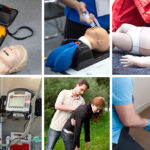Cardiopulmonary resuscitation (CPR) is a simple but crucial lifesaving technique to learn. It helps a bystander tackle sudden cardiac arrest cases more accurately. A bystander can work with an AED, which is a small device to keep someone’s heart beating after they’ve suffered a sudden cardiac arrest emergency. After cardiac failure, one’s heart will stop beating, so it’s essential that someone intervenes in order to get their heart pumping again. This is where CPR comes in. When performing CPR, a bystander will work to get the victim’s heart beating again. This applies even to the person with a pacemaker who is suffering from similar medical emergencies in front of a bystander.
CPR has helped many people to be revived. At American CPR Care Association, we work hard to train anyone who wants to learn and perform CPR. Our goal is to ensure all Americans learn life-saving skills.
We offer CPR/AED courses that serve to train people in proper resuscitation techniques. We have been working with our communities for many years and have coached people from all walks of life with our 100% online CPR training course. We offer our courses to medical professionals and also the general public, so everyone can continue to save victims like a person with a pacemaker whenever they are suffering from a cardiac arrest situation.
At American CPR Care Association, we often receive questions regarding whether or not CPR can be used on certain people. One thing that many people have concerns about is whether or not CPR can be performed on a person with a pacemaker.
In this blog, we are going to delve into the question of whether CPR can be used on someone with a pacemaker. Approximately 1.5 million Americans have a pacemaker, so this is an extremely important topic that everyone needs to understand in order to ensure that they’re offering the right kind of life-saving assistance in the event of cardiac arrest.
What is a Pacemaker?
Before we discuss whether or not CPR is appropriate for someone with a pacemaker, it’s important to first understand what exactly a pacemaker is.
In essence, a pacemaker is a small device, designed to withstand situations of bradycardia, and is placed under the skin directly over the heart. It works to regulate someone’s heartbeat when there are issues that are causing it to beat irregularly.
In order to obtain a pacemaker, one must undergo a surgical procedure. During that procedure, an electrical device (i.e., a pacemaker) is implanted under the skin to regulate the heart rhythm. The pacemaker is made up of two parts. One part is the pulse generator, which works to use the battery in the pacemaker to send electrical pulses to the heart when it is beating irregularly. The other part is made up of leads which actually transmit the electrical impulses directly to the heart.
Pacemakers help to control issues with the heart known as arrhythmias. In general, there are two types of arrhythmias. One is known as tachycardia, during which the heart beats too fast. The other is known as bradycardia, in which the heart beats too slow.
Both types of arrhythmias can be fatal if not managed properly. Thus, for people who are dealing with them, it may be necessary to receive a pacemaker in order to ensure that the heart is functioning correctly. If the heart starts beating too slow or too fast, the pacemaker is designed to withstand these situations and triggered to send an electrical signal to the heart in order to get it back to beating properly.
What is CPR?
In a general sense, CPR is a process that works to get the heart beating again. It is a fairly simple procedure. However, it is something that can be forgotten over time, so it’s important to keep your credentials up to date.
CPR consists of using chest compressions and rescue breaths. Chest compressions seek to mimic the beating of the heart. In order to perform them, place your palm on the victim’s chest and place your other hand over it. Then, begin pressing deeply and quickly in order to help to mechanically pump the heart and get the blood flowing through the body.
In addition, it’s important to attempt to supply fresh oxygen to the body in the event of cardiac arrest, so rescue breaths are also an important part of CPR. In order to perform rescue breaths, pinch the victim’s nose closed and tilt their head back. Then, blow two long, strong breaths into the victim’s mouth (while making a complete seal around their mouth with your own). Make sure you’re looking to see that the person’s chest is rising as you offer the rescue breaths. If it isn’t you may not be blowing hard enough or there may be an obstruction in the airway that you need to clear.
Using An AED On Someone
In addition to chest compressions and rescue breaths, it’s important to also try to use an AED on someone who is suffering from cardiac failure as well. An AED or automated external defibrillator works to offer an electrical shock to the heart. This is extremely important for someone who is suffering from cardiac arrest and can significantly increase their chances of surviving the emergency.
However, many people have questions about whether or not an AED is safe for a person with a pacemaker, as both devices offer an electrical impulse straight to the heart. In addition, people wonder about whether or not CPR, in general, should be applied to someone with a pacemaker. Continue reading as we explore these questions in depth.
Is CPR Safe for Someone with an AED Pacemaker?
Again, this is a very common question and one which is very valid considering all of the circumstances. The answer is that: Yes, CPR is completely safe for someone who has a pacemaker.
When it comes to basic CPR procedures, everything is essentially the same for someone with a pacemaker. It’s important to deliver chest compressions immediately, just as you would on someone without a pacemaker. Make sure you’re pressing deeply into the chest at a depth of about 1.5-2 inches or about one-third of the diameter of the chest. Provide 30 chest compressions at a rate of 100-120 bpm.
Remember that the key is to try to get the blood pumping through the heart and throughout the body. Thus, administering high-quality chest compressions is one of the most important aspects of proper CPR to regulate the heart rhythm once again for the patient. Because the pacemaker is placed directly above the heart and chest compressions are done slightly lower, in the center of the chest, there should be no interference.
In addition, it’s also important to still provide rescue breaths to someone who is suffering from cardiac arrest, even if they have a pacemaker. Make sure to complete a round of 30 chest compressions, and then switch over to offering 2 rescue breaths.
Can an AED Be Used on Someone with a Pacemaker?
In addition to chest compressions and rescue breaths, another important aspect of CPR is utilizing an AED. As explained above, and AED works to administer an electrical shock to the heart in order to restart it. AEDs can be extremely effective for CPR. In fact, according to the American Heart Association, AEDs have been shown to double the chances of someone’s survival when suffering from cardiac arrest outside of a hospital.
However, many bystanders have concerns when it comes to using an AED on someone with a pacemaker. Because both pacemakers and AEDs supply electrical currents to the heart, it’s understandable that people would be concerned about whether or not an AED would be safe to use.
However, thankfully, AEDs are absolutely safe to use on someone with a pacemaker. The one significant change that occurs when using an AED on someone with a pacemaker is to make sure to position the AED pads correctly. AED pads should always be placed on the upper right and lower left portions of the victim’s chest, surrounding the heart. However, when using an AED on someone with a pacemaker, it’s important to make sure that the electrical impulse from the AED doesn’t interfere with the pacemaker, so you must make sure to position the pads so that they are at least 1 inch away from the device.
Conclusion
Luckily, when it comes to performing CPR on someone with a pacemaker, the rules are almost the same. It’s important to administer high-quality chest compressions, along with rescue breaths in order to attempt to get blood and oxygen flowing throughout the body. In addition, an AED can still be used on someone with a pacemaker. However, it’s key that you place the pads at least 1 inch away from the device in order to ensure that the shock from the AED doesn’t interfere with the pacemaker.
American CPR Care Association is committed to providing our clients with quality CPR/AED certifications in order to ensure that as many people as possible are equipped to deal with the emergency of cardiac arrest. For more information or to schedule your training today, visit , or reach out to us at 1-888-808-9109 or [email protected].







